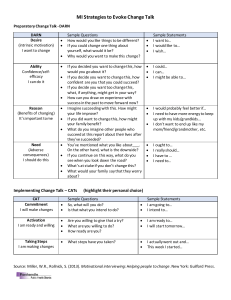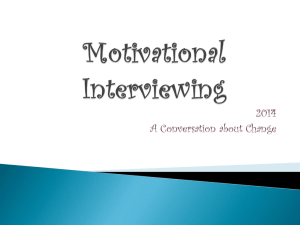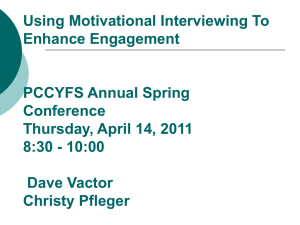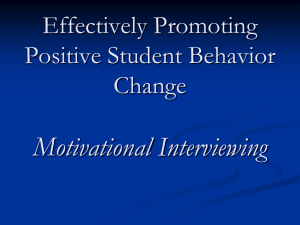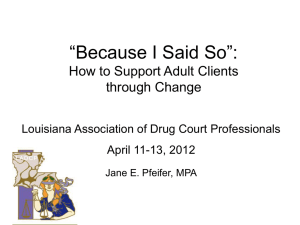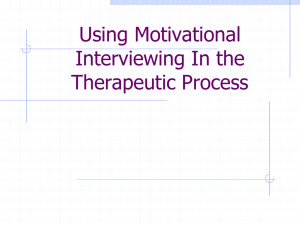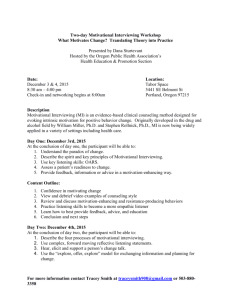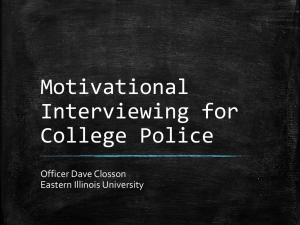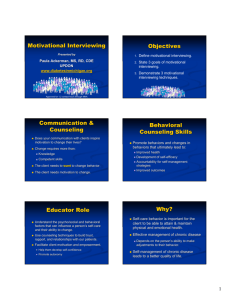Using Motivational Interviewing to Enhance Engagement
advertisement
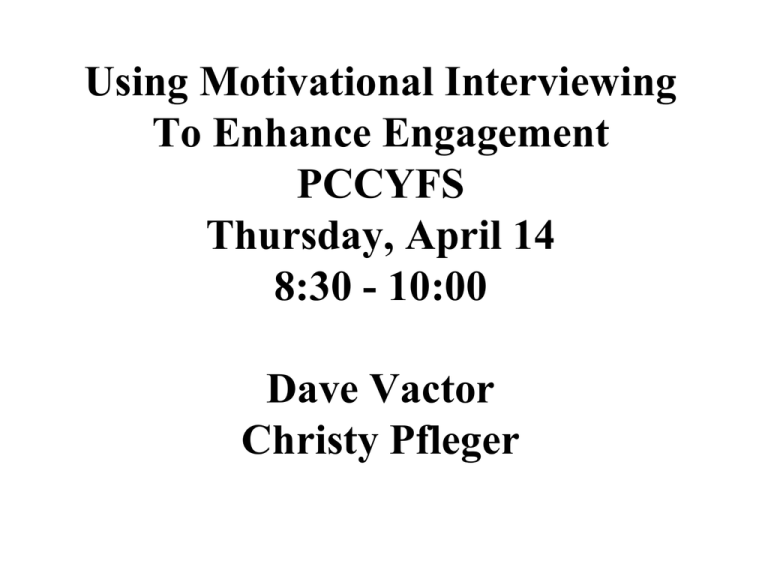
Using Motivational Interviewing To Enhance Engagement PCCYFS Thursday, April 14 8:30 - 10:00 Dave Vactor Christy Pfleger “MI Preparation Prayer” Guide me to be a patient companion To listen with a heart as open as the sky Grant me vision to see through her eyes And eager ears to hear her story Create a safe and open mesa on which we may walk together Make me a clear pool in which she may reflect Guide me to find in her your beauty and wisdom Knowing your desire for her to be in harmony-healthy, loving, strong Let me honor and respect her choosing of her own path And bless her to walk it freely May I know once again that although she and I are different Yet there is a peaceful place where we are one -Bill Miller, co-founder of MI Rollnick and Miller 1995 Purpose • Provide an overview of the process of change and basic MI skills • Explore how to use MI skills to effectively engage clients • Learn strategies to help clients tap into their motivation for change So What Exactly is MI? Definition: • A perspective that views a client as the most influential agent of change and aims to empower the client to actively engage in the process of change. • A method or approach, not a technique, that is not based on a singular theory. • “A directive, client-centered counseling style for eliciting behavior change by helping clients explore and resolve ambivalence.”-Rollnick and Miller, 1995 Rollnick and Miller 2006 History • MI was developed in 1983 by Bill Miller for use with substance abuse clients. – Empirical data has been collected for use of MI treatment with: drug and alcohol abuse, smoking cessation, psychiatric disorders, HIV related risk behaviors, diet and exercise. – Note: These effects did not diminish over time. Beliefs Essential to the MI process • Person-Centered (closely linked to Rogerian Theory) • Resistance to change and ambivalence are natural human processes • Lack of motivation=unresolved ambivalence • Negative feelings/experiences can inhibit change • Change occurs when it is connected to something of importance and value • The client needs to show you the reason for change in order to proceed successfully (“change talk”) Identifying “Change Talk” •What people say and how they talk about change is important. Defensiveness = Confrontation = Change Change Confidence and Self-Efficacy • When people and service providers believe that change can happen, it is more likely it will happen. • Self-efficacy= hope • Empathy facilitates change Miller & Rollnick’s “Spirit of MI” •Motivation to change is elicited from the client and not imposed from without •It is the clients task, not the counselor’s , to articulate and resolve their ambivalence •The therapeutic relationship is more like a partnership or companionship than expert/recipient roles Rollnick and Miller 2006 Approach • Direct persuasion is not an effective method for resolving ambivalence • The counseling style is generally a quiet and eliciting one Approach, continued •The counselor is directive in helping the client to examine and resolve ambivalence •Readiness to change is a not a client trait, but fluctuating product of interpersonal interaction Three Key Components • Collaborate (Partner) • Evocation (Draw Out) • Autonomy (Stand on own) Identifying “Change Talk” • Disadvantages of status quo • Advantages of change • Optimism • Intention to change What is Unique about MI? • MI is Directive • Client-Centered= focused on client’s interest and concerns • Do not teach new skill, alter thought patterns or look to the past • MI is a method of communication • Not something we do to, but we are with and for clients • Change is not forced or imposed (i.e., through punishment, pressure, financial gain) • The client is the expert Wheel of Change • Motivational Interviewing and the Transtheoretical model to change – developed separately but synchronously. • Trans-theoretical model of change is used to breakdown the concept of readiness to change into stages. • Use the Wheel of Change to assess what MI strategies to use for forward movement. Prochaska, Di Clemente and Norcross, 1992 Wheel of Change Prochaska, Di Clemente and Norcross, 1992 Stages of Change Phase I – Address Ambivalence • Pre-Contemplation • Contemplating Phase II Address Change/Changing Action • Preparation • Action • Maintenance Using MI with the Stages of Change • Each stage contains certain helping behaviors that are particularly constructive • Assist in measuring/gauging • Readiness • Confidence • Motivation Instead of asking “Why isn't this person motivated?” ask “What is this person motivated by?” Traps • Question-Answer – prevents discussion from getting to a deeper level • Taking Sides – encourages client to argue more for their current perspective • Expert – change is more effective when it comes from within, not without • Labeling • Premature Focus – increases defensiveness, decreases chances for longterm success Resistance Behaviors • • • • • Arguing Interrupting Denying Ignoring Overt compliance/Covert defiance Skills • • • • • • Get Permission Drawing from past successes Scaling Imagine ideal future and change needed to get there Extremes-worst and best possible outcomes of change Scaling Mandated Clients: • Acknowledge mandate • Provide choices • Empathize with lack of choice Principles • Express Empathy • Develop Discrepancies • Roll with Resistance • Support Self-Efficacy How to Make it Work • Express empathy- reference listening, reflective listening • Develop discrepancies – bring client on board with the importance for change, by highlighting differences • Between current behavior and personal values • Have the person argue for change Rolling with Resistance • • • • Accept it Respect it Flow with it “Roll with it” rather than oppose it Supporting Self-Efficacy • Empowering the client to be the change agent • Have confidence in his/her ability Elements of a Change Plan • • • • • • Goals Reasons Steps Support Obstacles Signs of Progress How to Use Skill (OARS) • • • • Ask open ended questions Affirm Reflective Listening Summarizing References Baer, J.S., Garrett .S.B., Beadnell, B,Wells E.A, & Peterson P.L., (2007). Brief Motivational Intervention With Homeless Adolescents: Evaluating Effects on Substance Use and Service Utilization, Psychology of Addictive Behaviors, 21, 582-586. Burke B.L., Arkowitz. H & Menchola. M., (2003). The Efficacy of Motivational Interviewing: A Meta-Analysis of Controlled Clinical Trials Journal of Consulting and Clinical Psychology, 21, 843-861. Miller, W. R., & Rollnick, S.,(1995). What is motivational interviewing? Behavioral and Cognitive Psychotherapy, 23, 325-334. Miller, W. R., & Rollnick, S., (2002). Motivational interviewing: Preparing people for change (2nd ed.) New York: Guilford Press. Petrocellim, J.V., (2002). Process and change: counseling with the transtheoretical model of change, Journal of Counseling and Development, 80, 22-28. Russell .C.R., Motivational Interviewing training for new trainers., (2002). The Motivational Interviewing Network of Trainers. Wagner,C, Ingersoll, C. (2008). Beyond cognition: broadening the emotional, base of motivational Interviewing Journal of Psychotherapy. Integration and American Psychological Association 18, 191–206. Wiles, M.,(2005). Motivational interviewing: overcoming client resistance to change. Cross Country Education Inc. Zuckoff, A., & Daley, D. C., (1999). Improving Treatment Compliance: Counseling & Systems Strategies for Substance Abuse & Dual Disorders.
